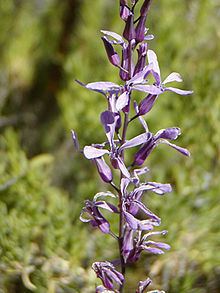Genus Thelypodium Rank Species | ||
 | ||
Similar Thelypodium, Stenogyne kanehoana, Plagiobothrys hirtus, Astragalus applegatei, Lomatium cookii | ||
Thelypodium howellii, the Howell's thelypody or Howell's thelypodium, is a rare plant of the Western United States. It is endemic to a relatively small area on the borders of three western States: Oregon, Nevada, and California.
Contents
Description
The Thelypodium howellii plant is biennial. It is often somewhat hairy, especially near the base, but may be hairless and waxy in texture. It produces a slender, branching, erect stem up to 70 centimeters tall. The leaves are mostly located in a rosette around the base. Leaves located higher on the stem may have clasping bases.
The inflorescence is a raceme of widely spaced flowers with greenish white or purplish sepals and pale blue or purple, spoon-shaped petals. The fruit is a silique up to 4.5 centimeters long containing plump brown seeds.
Subspecies
Distribution, habitat, and ecology
This plant is endemic to a small area stretching from north-eastern Oregon to north-eastern California. It lives in alkaline or adobe meadows and seeps, river valleys and moist plains in Great Basin sagebrush scrub. The fire ecology of this plant is not known at present.
Conservation status and threats
U.S. Forest Service Pacific Southwest Region Sensitive Species.
California Native Plant Society List 1B.2.
NatureServe California State Rank: S2.2; Global Rank: G2
The threats facing Howell's thelypody are not known at present.
Field identification
Howell's thelypody flowers from May to July. Var. spectabilis, known only from Malheur Co., Oregon, is larger than var. howellii, has larger, more strongly purple flowers, and is a federally listed species.
